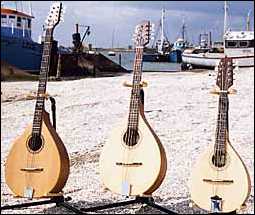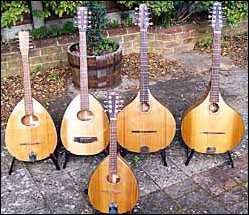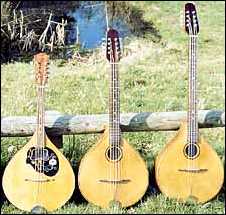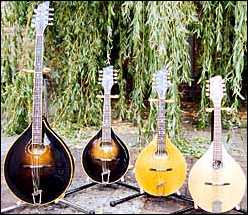
| THE HOBGOBLIN INFO SOURCE | |||
| HOBGOBLIN INDEX PAGE | HOBGOBLIN INFO INDEX | CATALOGUE CONTENTS | BOUZOUKI & MANDOLA ONLINE SALES | SECONDHAND PRICES |
| Bouzouki FAQ | ||
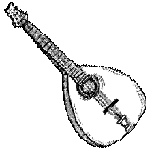 |
ON THIS PAGE: Under Construction! Bouzouki Makers Bouzouki Background RELATED PAGES: Care & Maintenance String Advice Page (soon) Tunings & Gauges |
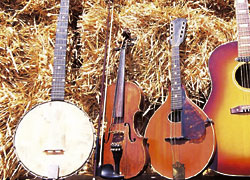 |
|
© Copyright Hobgoblin Music 1983, 2000. This text may be freely distributed in whole or in part so long as the copyright holder is clearly acknowledged. Bouzouki BackgroundBouzoukisThe Bouzouki is a long-necked Lute developed in Greece from its Turkish roots. It comes from a different branch of the lute family than the mandolas do. It was originally a 6 string instrument (DAD) but more modern Greek makers started making an 8 string bouzouki tuned CFAD, one tone below the top four of a guitar. The original Greek style bouzoukis are still very popular, both for Greek music, and accompanying traditional folk music. The bouzouki was picked up by irish musicians travelling abroad and adapted for their use by retuning to GDAE. Modern makers then started producing them with flat backs which made them almost identical to the octave mandola. The crucial difference is the scale length, which is longer. This can affect fingering, but also affects sound because the strings are thinner. Generally the mandolas are better at tunes, bouzoukis for accompanying, but this is not a strict rule. There is a fashion in bouzouki playing now to use slightly different tunings rather like guitar players do (see "The Irish Bouzouki"). In recent years it has been adapted for use in traditional Irish music, with a flat back construction replacing the original round back design. The 'Irish' Bouzouki has a brighter more open sound, and is easier to hold. The scale length is now generally a little shorter than Greek bouzoukis, and the distinction between Bouzouki and Octave Mandola (also known in America as Octave Mandolin) has become blurred, as the neck length is the only difference. We describe instruments with a scale longer than around 580mm as Bouzoukis. Tuning is either GDAE, or GDAD. Note: Roundback Greek bouzoukis have a longer scale length around 670mm, and are usually tuned to CFAD. Many flat back "Irish style" bouzoukis have a shorter neck, from around 610mm upwards, though they do also come with the full 670mm neck. String gauges need to be chosen to suit the neck length and tuning. MandolasThe big brother of the Mandolin, the Mandola retains the high-tension stringing but allows lower parts to be played. Octave Mandolas (also known as Octave Mandolins in America) are popular because of their suitability for Irish music, being tuned GDAE an octave below a Mandolin. Because the neck is shorter than a Bouzouki it is easier to finger, but the strings are heavier. The Mandola (or Tenor Mandola) is tuned as a Viola, CGDAMandocello and MandobassThe Mandocello is tuned CGDA one octave below the Mandola (however most of them will stand being tuned in GDAE like a bouzouki). The Mando Bass is a rare beast, but the examples we have had have been tuned the same as a String Bass EADGCitternsThe Cittern used by today's folk-bands has its ancestors in the renaissance Citterns and the English Guitar, but it is now more closely related to the flat-back Bouzouki - the main difference being that the Cittern has 10 strings in 5 courses, a slightly shorter neck and often a rather larger body. There doesn't seem to be a standard tuning, ADADA, ADGAD, or DGDAD, are in common use. The English Guitar or GuittarThey were more commonly used in Ireland and Scotland than in England and the leading exponents of the instrument were Scottish (James Oswald, who became court musician partly on the strength of this but was also an excellent fiddle player, and Robert Bremner). Oswald moved to London, bringing with him a craze for playing the guittar. His later published music moved away from Scottish songs, and adopted Italian style. The English guitar and the Scottish guittar are one and the same instrument. The term 'English guitar' was invented in this century to describe it, in the 18th century the spelling 'guittar' spelling always used for this instrument - they didn't call it English, or Scottish, or Irish or anything else, just a 'guittar'. The tuning from Bremner's tutor, the leading tutor book of the era, gives A=440, tune A C# E a c# e. Bouzouki MakersHathway
Fylde
Musikalia
Davidson
Back to the Top of the Page |
